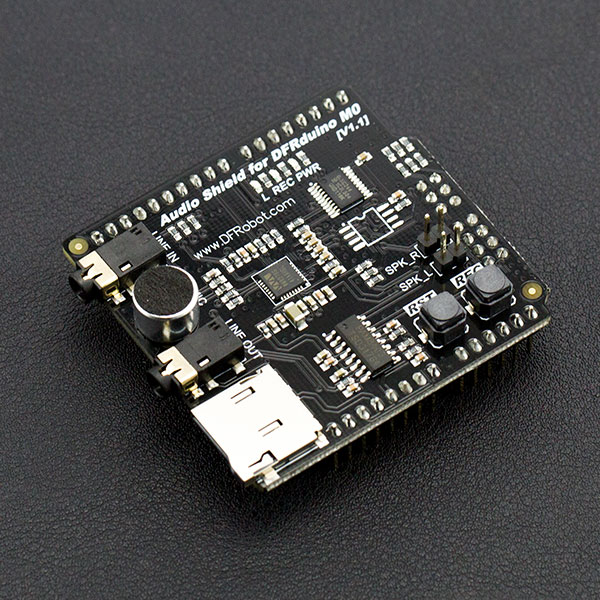Introduction
DFRduino M0 Audio Expansion Shield selects the latest full-featured WM8978 of Wolfson as the audio processor. It comes with HI-FI level digital signal processing kernel, supporting 3D surround-sound enhancement and 5 frequency bands balance which can improve the sound quality. With a programmable notch filter, it also can filter noise caused by current noise, etc.
Attributing to the plentiful hardware resource on DFRduino M0, we finally can transplant this HI-FI level codec chip to Arduino platform. Functions like dual channels playing, SD card storage, MONO recording and dual channels 3W PA (power amplification) are available even without serial port MP3 module. It is efficient in serial port resources, flexible in control and convenient to use.
DFRduino M0 Audio Expansion Shield adopts standard IIS interface, equipped with on-board MIC and 3.5mm audio jack, supporting external voice source input and output. It also has left and right channels speakers, which you can connect 3W trumpets.
 NOTE: DFRduino M0 Audio Expansion Shield uses IIS interface and it is only compatible with DFRduino M0 and Bluno M0 microconyrollers, not support common Arduino microcontrollers.
NOTE: DFRduino M0 Audio Expansion Shield uses IIS interface and it is only compatible with DFRduino M0 and Bluno M0 microconyrollers, not support common Arduino microcontrollers.
Feature
- WM8978 professional Hi-Fi codec chip
- Standard IIS interface
- Dual 3W amplifier
- Support onboard MIC, DC3.5 MIC Input
Specification
- Operating Voltage: 5V
- Maximum Operating Current: 2A
- Audio Format: wav file
- DFRduino M0 shield package
- Input Interface: 3.5mm MIC & On-board MIC
- Output Interface: 3.5MIC headphone & XH2.54 Speaker pins
- Dimension: 55mm * 53mm/2.16" * 2.08"
- Weight 26g
Board Overview

| Num | Label | Description |
|---|---|---|
| 1 | Linein | 3.5mm Microphone |
| 2 | Lineout | 3.5mm headset |
| 3 | Micro-SD | Micro-SD |
| 4 | Speaker_L | Left Speaker |
| 5 | Speaker_R | Right Speaker |
Tutorial
In this section, we'll display 2 examples: Play WAV music & Record your voice.
Requirements
- Hardware
-
- DFRduino M0 Mainboard x1
- Audio Shield for DFRduino M0 x1
- 3.5mm headphone or 3W Speaker
- MicroSD card with FAT format (Currently, exFAT is not supported. Please use FAT16 or FAT32 for formatting).
- Software
- Arduino IDE (Version requirements: V1.6+), [https://www.arduino.cc/en/software| Click to Download Arduino IDE from Arduino®]
Sample Code 1 —— Play WAV File
#include <SPI.h>
#include <Wire.h>
#include <SD.h>
#include <WAV.h>
// set up variables using the SD utility library functions:
Sd2Card card;
///< assign sd card chipselect pin
const int chipSelect = 30;
void setup()
{
// Open serial communications and wait for port to open:
Serial.begin(115200);
while (!Serial) {
; // wait for serial port to connect. Needed for Leonardo only
}
while(1){
Serial.print("\nInitializing SD card...");
// we'll use the initialization code from the utility libraries
// since we're just testing if the card is working!
if (!card.init(SPI_HALF_SPEED, chipSelect)) {
Serial.println("initialization failed. Things to check:");
Serial.println("* is a card inserted?");
Serial.println("* is your wiring correct?");
Serial.println("* did you change the chipSelect pin to match your shield or module?");
delay(2000);
continue;
} else {
Serial.println("Wiring is correct and a card is present.");
if (!SD.begin(chipSelect)) {
Serial.println("Card failed, or not present");
delay(2000);
continue;
}
break;
}
}
}
void loop()
{
int ret;
//assign music file and trigger transport dma
wav.play("test.wav");
do{
//We must continue to decode to provide data to the player
ret = wav.decode();
//user code
}while(ret == WAV_DECODING);
while(1);
}
Operating Steps
- Leave your wav file on the root of Micro-SD card. (Named with "test.wav") ,
- Insert your SD card into the SD card slot. Note: SD storage format must be FAT
- Plug in speakers or headphones
- Upload the sample code, open the serial port monitor, and it will play themusic.
Sample Code 2 ——Record
#include <SPI.h>
#include <Wire.h>
#include <SD.h>
#include <WAV.h>
// set up variables using the SD utility library functions:
Sd2Card card;
const int chipSelect = 30; ///< assign sd card chipselect pin
void setup()
{
// Open serial communications and wait for port to open:
Serial.begin(115200);
while (!Serial) {
; // wait for serial port to connect. Needed for Leonardo only
}
while(1){
Serial.print("\nInitializing SD card...");
// we'll use the initialization code from the utility libraries
// since we're just testing if the card is working!
if (!card.init(SPI_HALF_SPEED, chipSelect)) {
Serial.println("initialization failed. Things to check:");
Serial.println("* is a card inserted?");
Serial.println("* is your wiring correct?");
Serial.println("* did you change the chipSelect pin to match your shield or module?");
delay(2000);
continue;
} else {
Serial.println("Wiring is correct and a card is present.");
if (!SD.begin(chipSelect)) {
Serial.println("Card failed, or not present");
delay(2000);
continue;
}
break;
}
}
}
void loop()
{
int ret;
ret = wav.record("rec.wav");
unsigned int start = millis();
while(ret == WAV_ENCODING){
ret = wav.encode();
if(millis() - start > 5000){
wav.stop();
ret = WAV_ENCODE_END;
}
};
while(1);
}
Expected Results
Record the voice for 5 seconds.
FAQ
For any questions, advice or cool ideas to share, please visit the DFRobot Forum.
